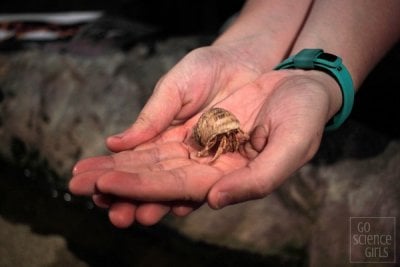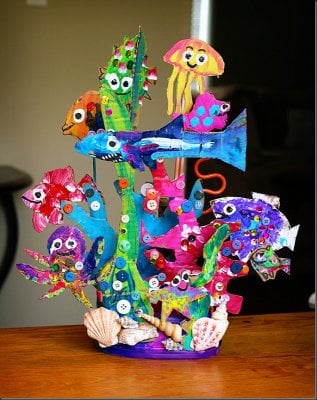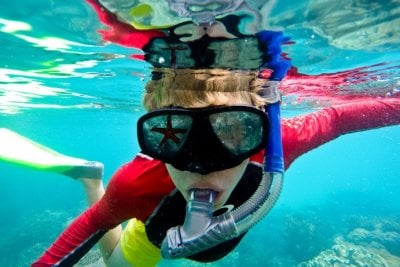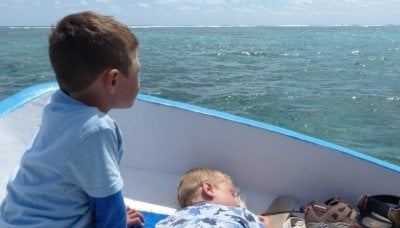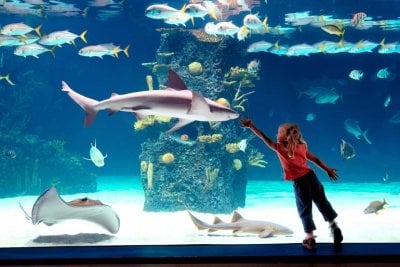All images are either public domain photos uploaded to various forms of social media, or used under Fair Use guidelines, as they best illustrate the article's content.
When my daughter was first born, I wasn’t sure how it would affect my ability to maintain a reef tank. Suddenly, in addition to being the sole caretaker of an underwater ecosystem, I had another human being that needed my full attention. Mixing that with work, I worried my beloved hobby of 20 years would finally fall to the wayside, lost in the shuffle of parenting and work. Naturally, when children are very young, all they can really do is ogle at an aquarium, offering some baby grins and giggles. I imagine like other parents/reef keepers, as my daughter got older, I learned that having children actually enriches your reef keeping experience. Yes, for a while, you may have to ease off the most demanding aspects of reef keeping, but once a child is old enough to understand how a reef aquarium works and just what inhabits one, you get an entirely new lease on the joys of reef keeping.
The enrichment goes both ways. At almost five years of age, my daughter is fluent in ocean ecology and can easily identify most coral, fish and invertebrate species. She is especially keen at identifying fish and seems enthralled with the most mundane tasks associated with reefing. While you may have never thought that cleaning a protein skimmer or capturing a wayward fish could be a lot of fun, throw a young child into the mix and experience the awe of their fascination. For children, this rich and exciting underwater world is brand new and often they are eager to explore it in vivid detail. The majority of our planet (between 70-80%) is covered by water. Beneath the ocean is the most diverse set of life found anywhere on planet Earth, ranging from shallow tropical reefs to underwater mountain ranges that dwarf the highest peaks here on land. It will likely be our children’s generation that breaks new ground in oceanic exploration. Much of the basis of biological study begins by understanding the various creatures that inhabit the ocean and how they came about over eons of evolutionary change.
A reef aquarium opens all that knowledge up to our children, while also providing an outlet for mechanical skills, knowledge and learning the dynamics of photosynthesis along with the importance of symbiotic relationships. In many ways, a reef aquarium is the ultimate scientific teaching tool and for the children of reef keepers, an exciting way to gain a deeper understanding of our world.
Start small:
For a while, I was sure to complete maintenance on my reef when my daughter was sleeping. Not only did it seem risky for the tank, to get stuck mid-water change or equipment breakdown, I didn’t want to be tied up where I couldn’t get to my daughter if she needed something (likely a snack or toy) immediately. Doing maintenance while she was up seemed too dangerous for her and my reef dwellers. As time went on, she started to wonder why I was always doing certain things to the tank. The epic childhood questions of “how” and “why” were starting to get asked. “Why do you put that food in first?” “How do those really slow snails get the food they need?” As a child’s interest in the mechanics of a tank grows, providing them with hands-on “projects” can help to flesh out the entire experience.
I started with small chores, like pulling the algae magnet out, putting fresh algae on the clip and then replacing it. Then I moved up to selecting an appropriate food (kids are masters of recognizing labels) and thawing it for feeding. Each baby step (no pun intended) secures firm footing for the next stage of learning. The main focus is ensuring that both your child and your reef is safe. Children aren’t afraid of much and it can be surprising how willing they are to eagerly explore using all their senses (including taste).
Now, my daughter can glue corals, frag small corals, feed the aquarium independently and even aid in changing out filtration media. The best part is, it makes mundane reef keeping chores fresh, exciting experiences as the wonder of a child is infectious. You’re quickly reminded what made you fall in love with reef keeping in the first place.
Allow hands-on interaction:
Kids like to touch, feel and hold everything. It’s almost as though they can’t comprehend something unless they’ve felt it in their hands and caressed each texture. My daughter loves to hold animals and is fascinated by how they react when she picks them up. When playing with the family dog or cat, this type of curiosity is pretty safe and healthy (for both parties). However, with a reef aquarium, it can be a little concerning, especially for reef keepers who’ve invested hundreds of hours and thousands of dollars into creating their slice of the ocean.
There is a myriad of reef creatures that simply cannot be picked up. The stress or potential damage of being held is too great and some aquatic animals pose a real risk to children. Zooanthid polyps for example release palytoxin, a serious poison that could put an adult, or child into the hospital. Anemones utilize nematocysts which attach to skin and release a burning, stinging zap. If you’re not totally fluent with all the capabilities of the animals within your tank, a good rule of thumb is, “if it looks like it stings, it probably does.”
That said, there are many animals within our tanks that are safe to hold and when handled carefully, withstand the interaction just fine. Hermit crabs for example are easily picked up and can be carefully handled without any damage to the crab, or the handler. They can withstand being out of water for short intervals and offer fun interaction for curious kids. The same can be said for many snail species and kids marvel at their ability to coax a snail out of their shell. With some guidance, children can also handle multiple species of nudibranchs, which will slow climb over hands and arms, something my daughter finds particularly enticing. Sea cucumbers are a long-time favorite in public aquarium touch tanks and those common to reef aquarium clean-up crews often allow for a strange experience for kids to pick and hold. Even a mollusk or amphipod can be exciting for a young child.
Some coral species can be held for short intervals. My favorite species for this has to be montipora frags, which can easily be removed from the water, with a frag plug that serves as a base for a child to grasp onto. In the wild, many montipora species spend time out of the water during low-tide and these corals can more than acclimate to some time out of water, being handled by a child.
It’s these interactions that seemingly fascinate children and also show them the importance of care and consideration, when intermingling with oceanic life. You can’t just grab any reef dweller indiscriminately and even those that can be handled need compassion and restraint. For children, a clump of macro-algae is its own little world, full of unique creatures just waiting to be discovered. I leave some live rock in my sump, so that it can become engulfed in tiny brittle starfish, snails and other creatures my daughter loves to pull off the rocks and put under a magnifying glass.
A lifelong lesson:
On one hand, exposing our children to our reef aquariums gives us a partner that can aid in routine maintenance and eventually even be competent eyes and ears if something goes awry while we’re away. If the hobby is to continue into the next generation, we will need young, curious and ambitious reef keepers to carry it and enhance the future of captive ocean life. Though the real gift of exposing young children is more universal, a potentially cultural impact that could make big difference for everyone. When children interact with ocean life, their vivid imaginations form unique relationships. They attribute personalities to fish and proudly provide names for even the most primitive reef creatures. This can lead into a lifelong appreciation of ocean life and foster within children an adult desire to protect it. If someone falls in love with ocean life as a child, then it’s very likely at some point in their life, disgrace about the decline of oceanic ecosystems will entice action. That action could be as simple as donating to a conservation group or as profound as entering marine science as a field of study and eventual profession.
Reef keepers 20 or 30 years from now, will likely partake in a hobby unrecognizable to those of us today. Not only will technological advancements and captive breeding programs revolutionize marine aquaria, issues like environmental stability and animal welfare will be on the forefront of anything involving live animals. Already, we are seeing conservation groups, non-governmental organizations (NGOs) and even legislative authorities working to ensure marine aquaria is not having a measurable negative impact on wild reef ecosystems. That is most likely to continue and it must, if we are to preserve what is left of worldwide coral reefs and diverse ocean life.
Children of the green revolution:
The past eight years have seen great advances in solar and wind energy, while various industries have taken part in what’s been called a “green renaissance.” The way we heat our homes, power devices and live modern lives has changed, in many cases for the better. Society is learning that green living is actually economically positive and provides all the conveyances expected of 21st century life.
Children that know oceanic life and have personal relationships with it, will more than likely be compelled to take action to protect it and also be more willing to accept green advances. If a child knows that using a certain product can harm ocean life, as an adult they may be inspired to choose something different, even if it carries a greater cost. This is perhaps still the strongest argument for the positive environmental side of marine aquaria and one that many aquarists can directly contribute too, simply by hanging out with our kids.
When my daughter was first born, I wasn’t sure how it would affect my ability to maintain a reef tank. Suddenly, in addition to being the sole caretaker of an underwater ecosystem, I had another human being that needed my full attention. Mixing that with work, I worried my beloved hobby of 20 years would finally fall to the wayside, lost in the shuffle of parenting and work. Naturally, when children are very young, all they can really do is ogle at an aquarium, offering some baby grins and giggles. I imagine like other parents/reef keepers, as my daughter got older, I learned that having children actually enriches your reef keeping experience. Yes, for a while, you may have to ease off the most demanding aspects of reef keeping, but once a child is old enough to understand how a reef aquarium works and just what inhabits one, you get an entirely new lease on the joys of reef keeping.
The enrichment goes both ways. At almost five years of age, my daughter is fluent in ocean ecology and can easily identify most coral, fish and invertebrate species. She is especially keen at identifying fish and seems enthralled with the most mundane tasks associated with reefing. While you may have never thought that cleaning a protein skimmer or capturing a wayward fish could be a lot of fun, throw a young child into the mix and experience the awe of their fascination. For children, this rich and exciting underwater world is brand new and often they are eager to explore it in vivid detail. The majority of our planet (between 70-80%) is covered by water. Beneath the ocean is the most diverse set of life found anywhere on planet Earth, ranging from shallow tropical reefs to underwater mountain ranges that dwarf the highest peaks here on land. It will likely be our children’s generation that breaks new ground in oceanic exploration. Much of the basis of biological study begins by understanding the various creatures that inhabit the ocean and how they came about over eons of evolutionary change.
A reef aquarium opens all that knowledge up to our children, while also providing an outlet for mechanical skills, knowledge and learning the dynamics of photosynthesis along with the importance of symbiotic relationships. In many ways, a reef aquarium is the ultimate scientific teaching tool and for the children of reef keepers, an exciting way to gain a deeper understanding of our world.
Start small:
For a while, I was sure to complete maintenance on my reef when my daughter was sleeping. Not only did it seem risky for the tank, to get stuck mid-water change or equipment breakdown, I didn’t want to be tied up where I couldn’t get to my daughter if she needed something (likely a snack or toy) immediately. Doing maintenance while she was up seemed too dangerous for her and my reef dwellers. As time went on, she started to wonder why I was always doing certain things to the tank. The epic childhood questions of “how” and “why” were starting to get asked. “Why do you put that food in first?” “How do those really slow snails get the food they need?” As a child’s interest in the mechanics of a tank grows, providing them with hands-on “projects” can help to flesh out the entire experience.
I started with small chores, like pulling the algae magnet out, putting fresh algae on the clip and then replacing it. Then I moved up to selecting an appropriate food (kids are masters of recognizing labels) and thawing it for feeding. Each baby step (no pun intended) secures firm footing for the next stage of learning. The main focus is ensuring that both your child and your reef is safe. Children aren’t afraid of much and it can be surprising how willing they are to eagerly explore using all their senses (including taste).
Now, my daughter can glue corals, frag small corals, feed the aquarium independently and even aid in changing out filtration media. The best part is, it makes mundane reef keeping chores fresh, exciting experiences as the wonder of a child is infectious. You’re quickly reminded what made you fall in love with reef keeping in the first place.
Allow hands-on interaction:
Kids like to touch, feel and hold everything. It’s almost as though they can’t comprehend something unless they’ve felt it in their hands and caressed each texture. My daughter loves to hold animals and is fascinated by how they react when she picks them up. When playing with the family dog or cat, this type of curiosity is pretty safe and healthy (for both parties). However, with a reef aquarium, it can be a little concerning, especially for reef keepers who’ve invested hundreds of hours and thousands of dollars into creating their slice of the ocean.
There is a myriad of reef creatures that simply cannot be picked up. The stress or potential damage of being held is too great and some aquatic animals pose a real risk to children. Zooanthid polyps for example release palytoxin, a serious poison that could put an adult, or child into the hospital. Anemones utilize nematocysts which attach to skin and release a burning, stinging zap. If you’re not totally fluent with all the capabilities of the animals within your tank, a good rule of thumb is, “if it looks like it stings, it probably does.”
That said, there are many animals within our tanks that are safe to hold and when handled carefully, withstand the interaction just fine. Hermit crabs for example are easily picked up and can be carefully handled without any damage to the crab, or the handler. They can withstand being out of water for short intervals and offer fun interaction for curious kids. The same can be said for many snail species and kids marvel at their ability to coax a snail out of their shell. With some guidance, children can also handle multiple species of nudibranchs, which will slow climb over hands and arms, something my daughter finds particularly enticing. Sea cucumbers are a long-time favorite in public aquarium touch tanks and those common to reef aquarium clean-up crews often allow for a strange experience for kids to pick and hold. Even a mollusk or amphipod can be exciting for a young child.
Some coral species can be held for short intervals. My favorite species for this has to be montipora frags, which can easily be removed from the water, with a frag plug that serves as a base for a child to grasp onto. In the wild, many montipora species spend time out of the water during low-tide and these corals can more than acclimate to some time out of water, being handled by a child.
It’s these interactions that seemingly fascinate children and also show them the importance of care and consideration, when intermingling with oceanic life. You can’t just grab any reef dweller indiscriminately and even those that can be handled need compassion and restraint. For children, a clump of macro-algae is its own little world, full of unique creatures just waiting to be discovered. I leave some live rock in my sump, so that it can become engulfed in tiny brittle starfish, snails and other creatures my daughter loves to pull off the rocks and put under a magnifying glass.
A lifelong lesson:
On one hand, exposing our children to our reef aquariums gives us a partner that can aid in routine maintenance and eventually even be competent eyes and ears if something goes awry while we’re away. If the hobby is to continue into the next generation, we will need young, curious and ambitious reef keepers to carry it and enhance the future of captive ocean life. Though the real gift of exposing young children is more universal, a potentially cultural impact that could make big difference for everyone. When children interact with ocean life, their vivid imaginations form unique relationships. They attribute personalities to fish and proudly provide names for even the most primitive reef creatures. This can lead into a lifelong appreciation of ocean life and foster within children an adult desire to protect it. If someone falls in love with ocean life as a child, then it’s very likely at some point in their life, disgrace about the decline of oceanic ecosystems will entice action. That action could be as simple as donating to a conservation group or as profound as entering marine science as a field of study and eventual profession.
Reef keepers 20 or 30 years from now, will likely partake in a hobby unrecognizable to those of us today. Not only will technological advancements and captive breeding programs revolutionize marine aquaria, issues like environmental stability and animal welfare will be on the forefront of anything involving live animals. Already, we are seeing conservation groups, non-governmental organizations (NGOs) and even legislative authorities working to ensure marine aquaria is not having a measurable negative impact on wild reef ecosystems. That is most likely to continue and it must, if we are to preserve what is left of worldwide coral reefs and diverse ocean life.
Children of the green revolution:
The past eight years have seen great advances in solar and wind energy, while various industries have taken part in what’s been called a “green renaissance.” The way we heat our homes, power devices and live modern lives has changed, in many cases for the better. Society is learning that green living is actually economically positive and provides all the conveyances expected of 21st century life.
Children that know oceanic life and have personal relationships with it, will more than likely be compelled to take action to protect it and also be more willing to accept green advances. If a child knows that using a certain product can harm ocean life, as an adult they may be inspired to choose something different, even if it carries a greater cost. This is perhaps still the strongest argument for the positive environmental side of marine aquaria and one that many aquarists can directly contribute too, simply by hanging out with our kids.



